BUICK PARK AVENUE 1994 Service Manual
Manufacturer: BUICK, Model Year: 1994, Model line: PARK AVENUE, Model: BUICK PARK AVENUE 1994Pages: 324, PDF Size: 17.01 MB
Page 41 of 324
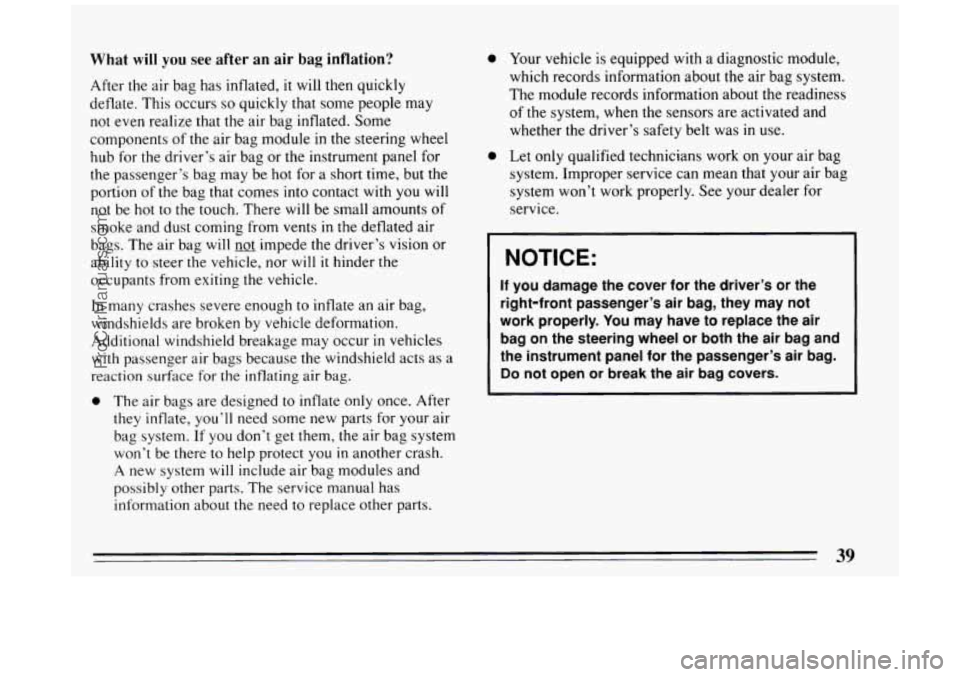
What will you see after an air bag inflation?
After the air bag has inflated, it will then quickly
deflate. This occurs
so quickly that some people may
not even realize that the air bag inflated. Some
components of the air bag module
in the steering wheel
hub for the driver’s air bag or the instrument panel for
the passenger’s bag may be hot for a short time, but the
portion of the bag that comes into contact with you will
not be hot to the touch. There will be small amounts
of
smoke and dust coming from vents in the deflated air
bags. The air bag
will not impede the driver’s vision or
ability to steer the vehicle,
nor will it hinder the
occupants from exiting the vehicle.
In many crashes severe enough to inflate an air bag,
windshields are broken by vehicle deformation.
Additional windshield breakage may occur in vehicles
with passenger air bags because the windshield acts as a
reaction surface for the inflating air bag.
0 The air bags are designed to inflate only once. After
they inflate, you’ll need some
new parts for your air
bag system. If you don’t get them, the air bag system
won’t be there to help protect you
in another crash.
A new system will include air bag modules and
possibly other parts. The service manual has
information about the need to replace other parts.
0
0
Your vehicle is equipped with a diagnostic module,
which records information about the air bag system.
The module records information about the readiness
of the system, when the sensors are activated and
whether the driver’s safety belt was
in use.
Let only qualified technicians work
on your air bag
system. Improper service can mean that your
air bag
system won’t work properly. See your dealer for
service.
NOTICE:
If you damage the cover for the driver’s or the
right-front passenger’s air bag, they may not
work properly. You may have to replace the air
bag on the steering wheel or both the air bag and
the instrument panel for the passenger’s air bag.
Do not open or break the air bag covers.
39
ProCarManuals.com
Page 42 of 324
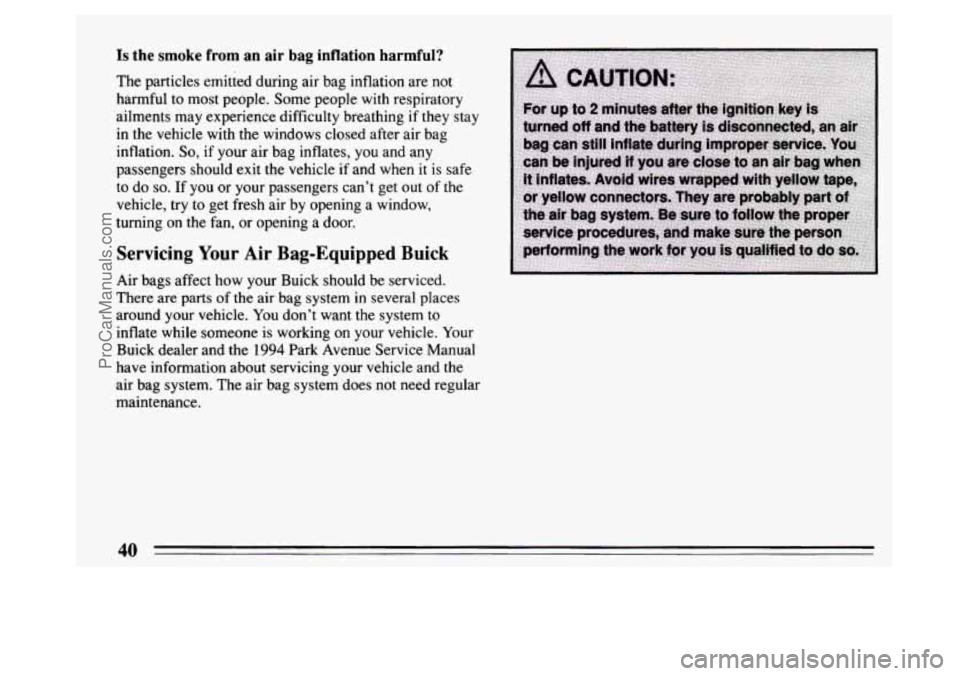
Is the smoke from an air bag inflation harmful?
The particles emitted during air bag inflation are not
harmful to most people. Some people with respiratory
ailments may experience difficulty breathing if they stay
in the vehicle with the windows closed after air bag
inflation.
So, if your air bag inflates, you and any
passengers should exit the vehicle if and when it
is safe
to do so. If you or your passengers can’t get out of the
vehicle, try to get fresh air by opening a window,
turning on the fan, or opening a door.
Servicing Your Air Bag-Equipped Buick
Air bags affect how your Buick should be serviced.
There
are parts of the air bag system in several places
around your vehicle. You don’t want the system to
inflate while someone
is working on your vehicle. Your
Buick dealer and the
1994 Park Avenue Service Manual
have information about servicing your vehicle and
the
air bag system. The air bag system does not need regular
maintenance.
40
ProCarManuals.com
Page 43 of 324
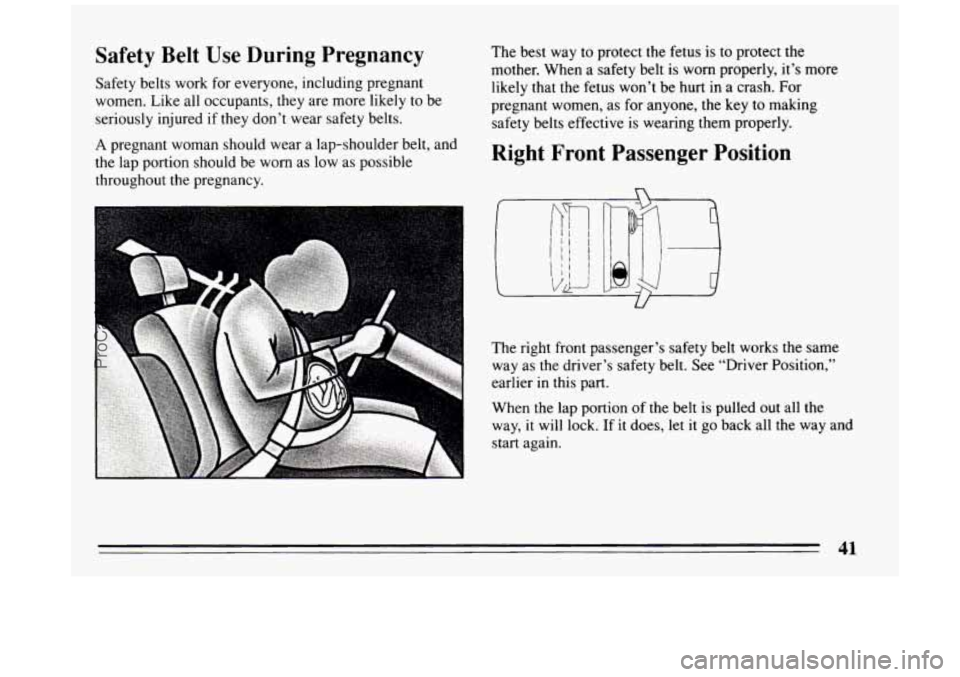
Safety Belt Use During Pregnancy
Safety belts work for everyone, including pregnant
women. Like all occupants,
they are more likely to be
seriously injured if they don’t wear safety belts.
A pregnant woman should wear a lap-shoulder belt, and
the lap portion should be worn as low as possible
throughout the pregnancy. The
best way
to protect the fetus is to protect the
mother. When a safety belt is worn properly, it’s more
likely that the fetus won’t be hurt in a crash.
For
pregnant women, as for anyone, the key to making
safety belts effective
is wearing them properly.
Right Front Passenger Position
The right front passenger’s safety belt works the same
way as the driver’s safety belt. See “Driver Position,”
earlier
in this part.
When the lap portion
of the belt is pulled out all the
way, it will lock. If it does,
let it go back all the way and
start again.
41
ProCarManuals.com
Page 44 of 324
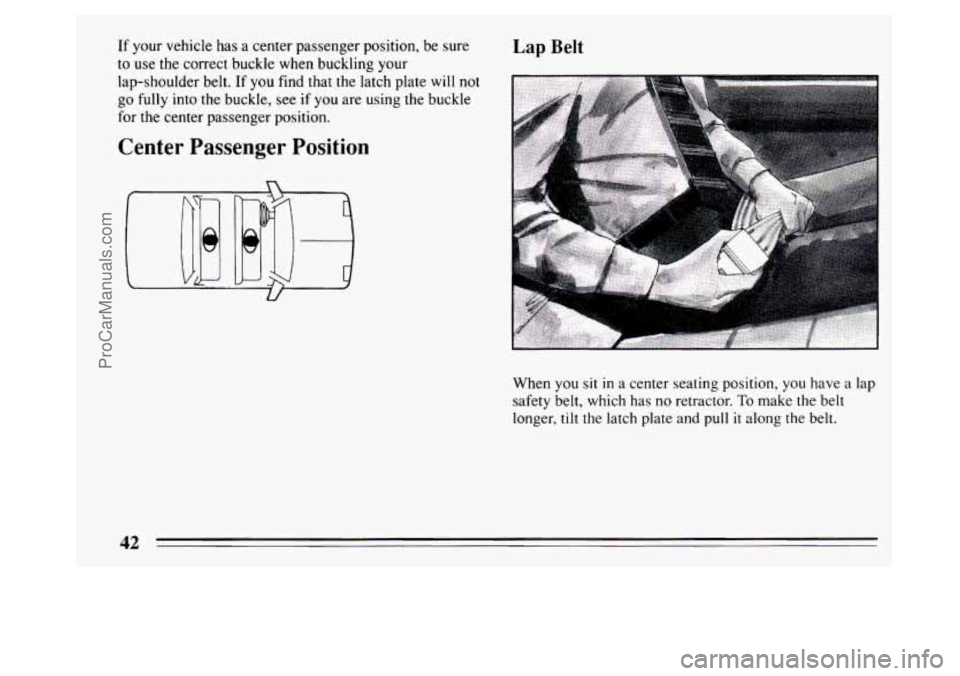
If your vehicle has a center passenger position, be sure
to use the correct buckle when buckling your
lap-shoulder belt. If
you find that the latch plate will not
go fully into the buckle, see if you are using the buckle
for the center passenger position.
Center Passenger Position
f
1
Lap Belt
When you sit in a center seating position, you have a lap
safety belt, which has
no retractor. To make the belt
longer,
tilt the latch plate and pull it along the belt.
ProCarManuals.com
Page 45 of 324
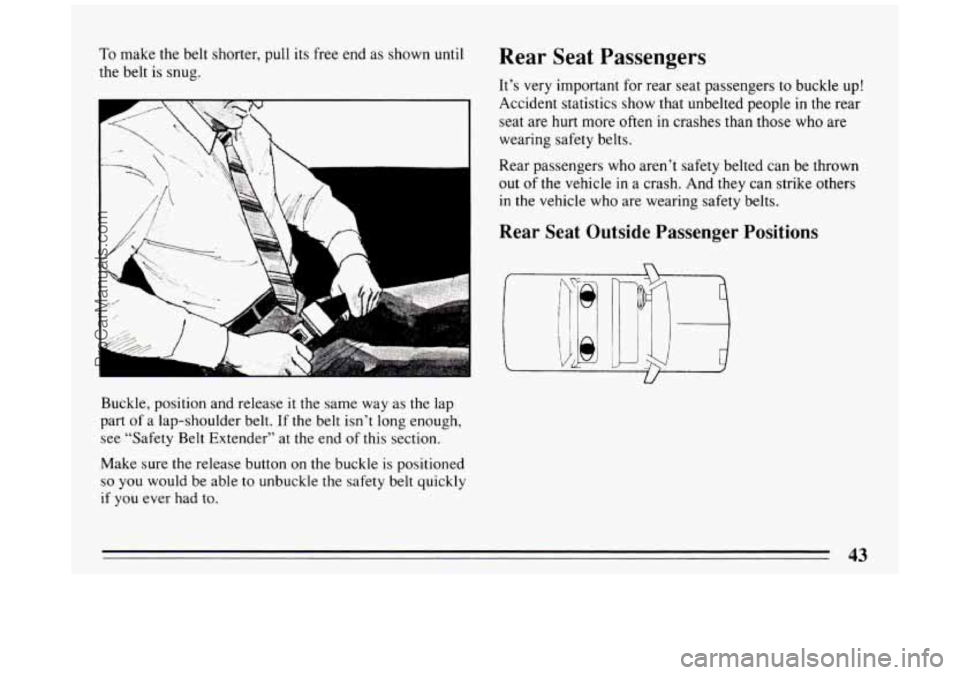
To make the belt shorter, pull its free end as shown until
the belt is snug.
Buckle, position and release
it the same way as the lap
part
of a lap-shoulder belt. If the belt isn’t long enough,
see “Safety Belt Extender” at the end
of this section.
Make sure the release button on the buckle
is positioned
so you would be able to unbuckle the safety belt quickly
if you ever had to.
Kear Seat Passengers
It’s very important for rear seat passengers to buckle up!
Accident statistics show that unbelted people in the rear
seat are
hurt more often in crashes than those who are
wearing safety belts.
Rear passengers who aren’t safety belted can be thrown
out of the vehicle in a crash. And they can strike others
in the vehicle who are wearing safety belts.
Rear Seat Outside Passenger Positions
43
ProCarManuals.com
Page 46 of 324
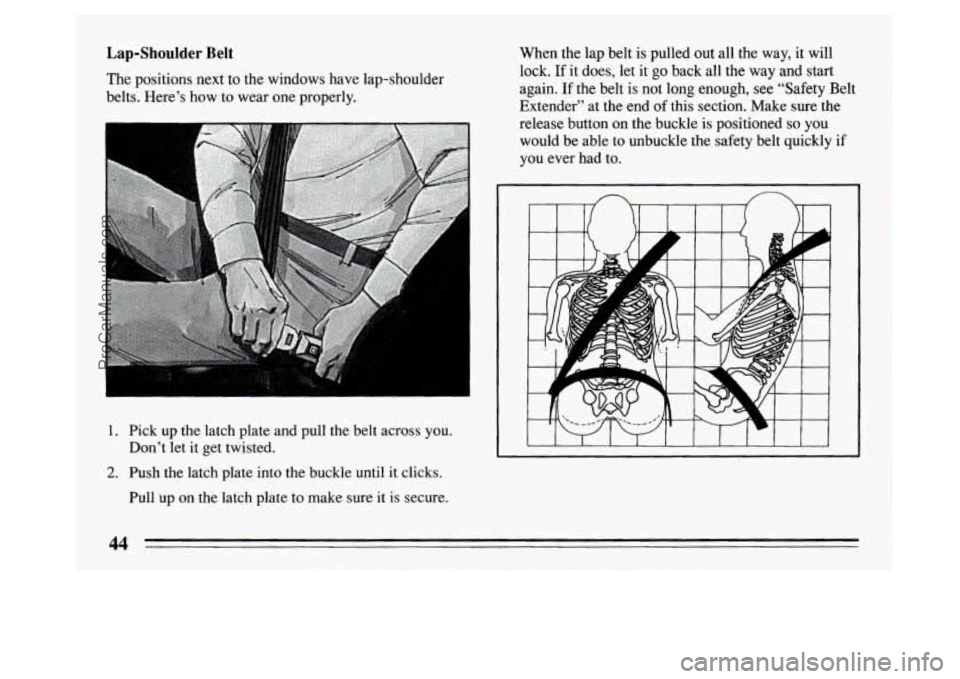
Lap-Shoulder Belt
The positions next to the windows have lap-shoulder
belts. Here’s how to wear one properly.
1. Pick up the latch plate and pull the belt across you.
Don’t let it get twisted.
2. Push the latch plate into the buckle until it clicks.
Pull up on the latch plate to make sure it is secure. When the
lap belt is pulled out all the way, it will
lock.
If it does, let it go back all the way and start
again. If the belt is not long enough, see “Safety Belt
Extender” at the end
of this section. Make sure the
release button on the buckle is positioned
so you
would be able to unbuckle the safety belt quickly if
you ever had to.
ProCarManuals.com
Page 47 of 324
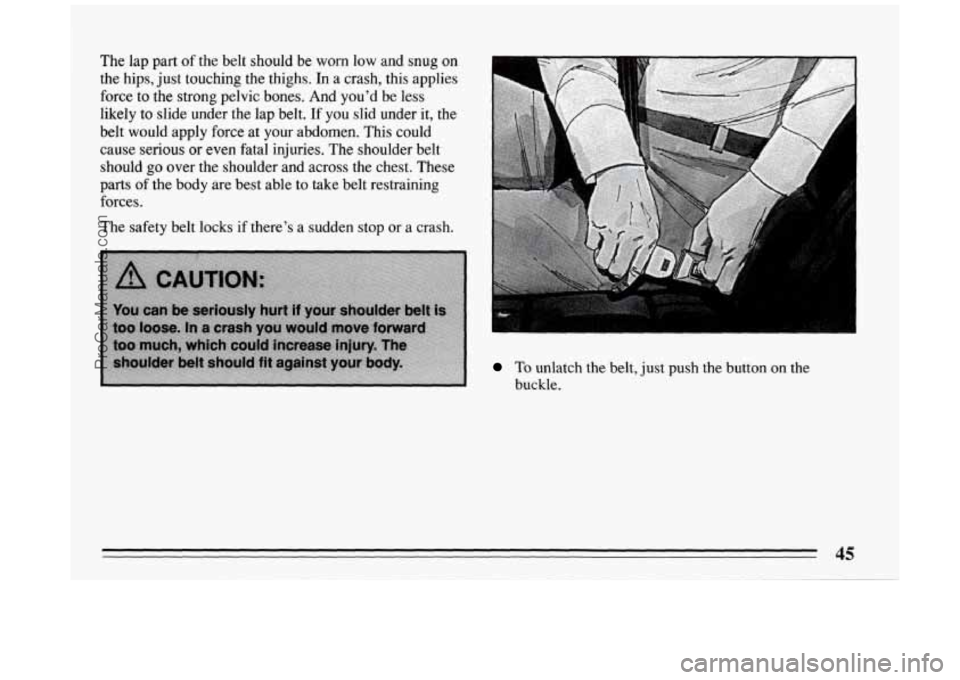
The lap part of the belt should be worn low and snug on
the hips, just touching the thighs.
In a crash, this applies
force to the strong pelvic bones. And you’d be less
likely to slide under the lap belt.
If you slid under it, the
belt would apply force at your abdomen. This could
cause serious or even fatal injuries. The shoulder belt
should go over the shoulder and across the chest. These
parts
of the body are best able to take belt restraining
forces.
The safety belt locks if there’s a sudden stop or a crash.
To unlatch the belt, just push the button on the
buckle.
45
ProCarManuals.com
Page 48 of 324

Children Smaller Children and Babies
Everyone in a vehicle needs protection! That includes
infants and all children smaller than adult size. In fact,
the law in every state in the United States and in every
Canadian province says children up to
some age must be
restrained while in a vehicle.
ProCarManuals.com
Page 49 of 324
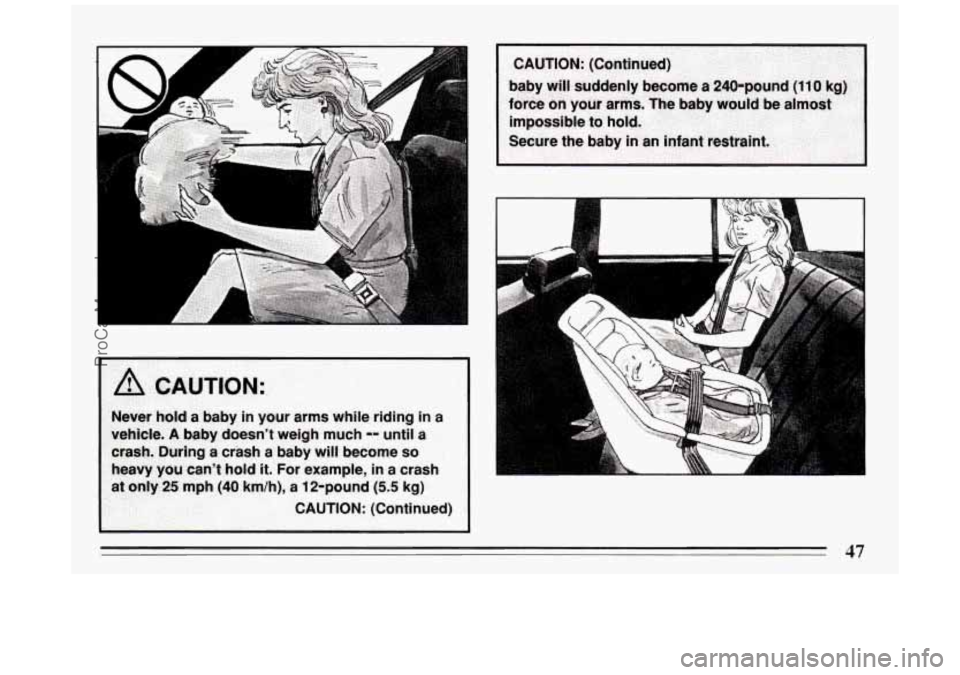
A
A
A
47
ProCarManuals.com
Page 50 of 324
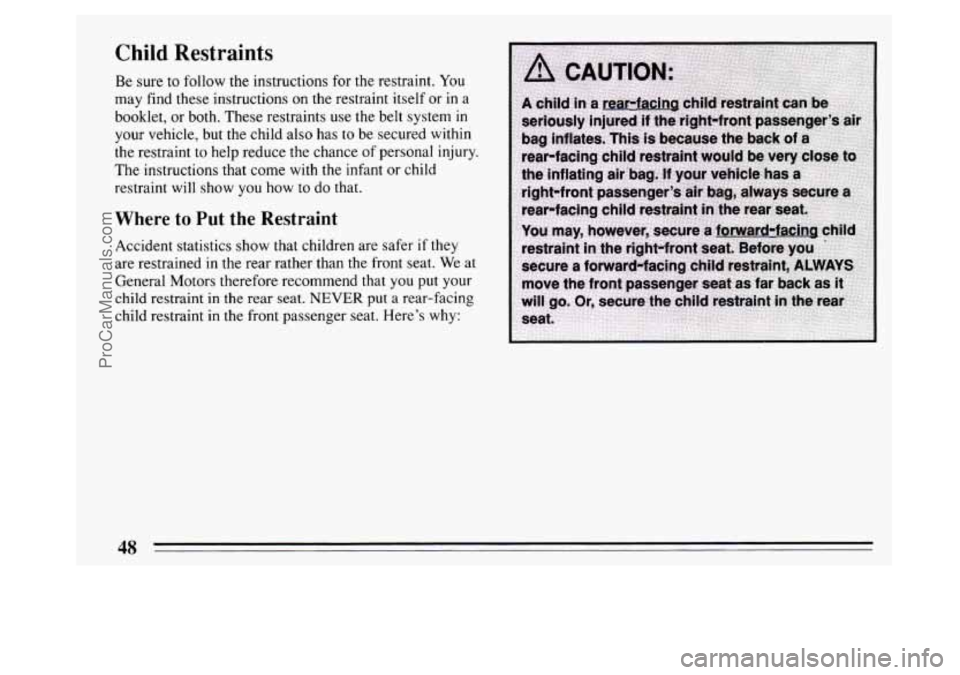
Child Restraints
Be sure to follow the instructions for the restraint. You
may find these instructions on the restraint itself or in a
booklet, or both. These restraints use the belt system in
your vehicle, but the child also has to be secured within
the restraint to help reduce the chance
of personal injury.
The instructions that come with the infant or child
restraint will show you how to do that.
Where to Put the Restraint
Accident statistics show that children are safer if they
are restrained
in the rear rather than the front seat. We at
General Motors therefore recommend that you put your
child restraint in the rear seat. NEVER put a rear-facing
child restraint
in the front passenger seat. Here’s why:
48
ProCarManuals.com